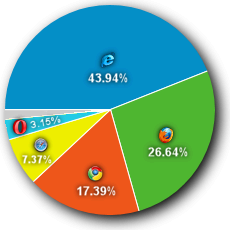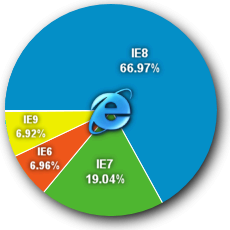 In 2011, we reported that many well known sites like Google, YouTube, Hotmail, WordPress, had taken the decision to drop support for the Microsoft’s decade old browser, Internet Explorer 6.
In 2011, we reported that many well known sites like Google, YouTube, Hotmail, WordPress, had taken the decision to drop support for the Microsoft’s decade old browser, Internet Explorer 6.
We also dropped IE6 support for our own web based room booking system, MIDAS in 2010.
But now it looks like major sites are starting to phase out support for Internet Explorer 7 too! …starting this week with Facebook.
Now, if you’re an avid Facebook user, you’ll probably have noticed their new “Timeline” feature. That is, unless you’re using Internet Explorer 7!
While more recent browsers can now access Facebook’s new Timeline profile feature, IE7 users are prevented from using this by Facebook! Instead, IE7 users can only see the old-style profile pages.
It’s likely, therefore, that in the near future, Facebook may drop support for IE7 entirely. You can be sure that other websites will be following suit during the course of 2012.
We here at MIDAS HQ think this will be a good thing!
Since IE7 was released, there have been two major updates (IE8 and IE9).
Keeping Updated
With Internet Explorer 10 being available around the time that the Windows 8 operating system will be launched, we always encourage our users to use the most recent version of their favorite browser available to them.
Keeping your browser up-to-date is essential. It helps ensure you’re protected from the latest security vulnerabilities. It also allows you to view websites (and web-based software, such as MIDAS) as the developers intended!
Many modern browsers keep themselves up-to-date with minimal user intervention required. As such, we were encouraged to learn earlier this month that in 2012 Internet Explorer will also begin automatically updating itself!
Although we strongly encourage our users to use IE9, at time of writing, we continue to provide support for MIDAS running under IE7. However, globally, IE7 users currently make up just 4% of PC web browser users. That’s according to StatCounter, and it’s a number that is ever declining.
Consequently, we are very likely to phase out support for MIDAS running in IE7 too before too long!
So if you’re still stuck on Internet Explorer 7… isn’t it about time you updated your browser!?
 So, no sooner do we blog about the
So, no sooner do we blog about the 

 Whilst Microsoft do provide some helpful resources for corporate IT departments looking to migrate from IE6, Microsoft have committed to continue support for IE6 until 2014 (coinciding with the “End of Life” of Windows XP), primarily because of this corporate sector! In our opinion, Microsoft should have ended support for IE6 a long time ago. If they had, it would force corporations and developers alike to upgrade and modernize their software. Ultimately, this benefits the wider Internet community! Developers can then utilize new and emerging web technologies, such as HTML5, CSS3. This in turn provides a better user experience, rather than developers having to instead spend time trying to make their modern software backwards compatible with a decade old obsolete browser!
Whilst Microsoft do provide some helpful resources for corporate IT departments looking to migrate from IE6, Microsoft have committed to continue support for IE6 until 2014 (coinciding with the “End of Life” of Windows XP), primarily because of this corporate sector! In our opinion, Microsoft should have ended support for IE6 a long time ago. If they had, it would force corporations and developers alike to upgrade and modernize their software. Ultimately, this benefits the wider Internet community! Developers can then utilize new and emerging web technologies, such as HTML5, CSS3. This in turn provides a better user experience, rather than developers having to instead spend time trying to make their modern software backwards compatible with a decade old obsolete browser!